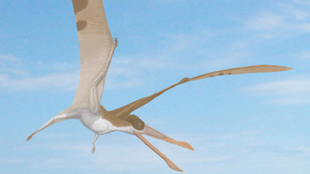New Pterosaur Discovered in China
Named Guidraco venator for “ghost dragon hunter,” a 120 million-year-old fossil skull appears most closely related to pterosaurs found in Brazil.
| March 5, 2012
 An example of an Early Cretaceous Brazilian pterosaur. Wikimedia Commons, Smokeyb*****
An example of an Early Cretaceous Brazilian pterosaur. Wikimedia Commons, Smokeyb*****
A new pterosaur fossil discovered in China supports global distribution of pterosaurs, a type of flying reptile that soared over dinosaurs 210 to 65 million years ago. The new fossil, namedGuidraco venator for the Chinese and Latin for “ghost dragon hunter,” was discovered in the Jiufotang Formation, an Early Cretaceous geological formation in northeast China. Despite this, G. venatorappears most closely related toLudodactylus sibbicki, a species identified in Brazil in 2003, reported Wired Science.
The study’s authors suggest that G. venator hunted for fish, based on its long, needle-like teeth and nearby fossilized feces containing fish bones. Some experts disagree with this conclusion, arguing instead that G. venator were more likely scavengers like L. sibbicki is believed to have been.
“Just imagine yourself as this creature. How would you catch living fish with such needles? You have no fingers, no fork, nothing to remove a fish if it gets stuck,” Eberhard “Dino” Frey, a paleontologist at the State Museum of Natural History in Karlsruhe, who was not involved with the study, told Wired. “They might have randomly collected what was there and probed it with a spaghetti-like tongue. If edible, they’d eat it. If not, they’d bump it out.”
Paleontologists hope G. venator presages more globally-distributed pterosaur finds in the future.
“We can [now] hope to find them anywhere in the world where Early Cretaceous strata crop out,”David Martill, a paleontologist at the University of Portsmouth, who did not participate in the research, told Wired.